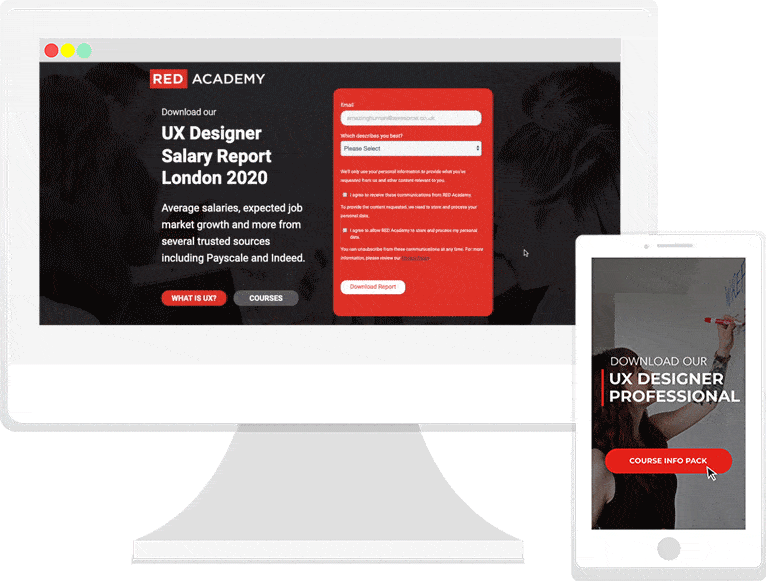Background

RED Academy was a tech and design school offering programs in digital marketing, UX/UI Design and front end web development. I worked on the commercial team for several months on the Digital Marketing team. The AOV for the courses offered was approximately $10,000 CAD which students either financed privately or received support for from third party organizations. I worked as part of a small, incredible team, reporting to the Director of Marketing. Being a global team, we became experts at remote collaboration and kept things moving using a range of communication tools including Zoom, Slack and Asana.

I began in a full-time instructional role, teaching the digital marketing program in Vancouver covering everything from analytics, SEO and market research to content marketing and paid acquisition strategies. Fortunately, the role was very hands on as the course included many practical components including real client projects for the students.
Responsibilities
My primary responsibility was lead generation through paid search and social channels, but I was also able to contribute greatly to marketing automation efforts using Hubspot and the development of a new global content strategy.

As part of my involvement in content creation, I produced and distributed a branded podcast series which was affectionately crowd-named REDio by our community. Episodes followed an interview format and served to help establish RED Academy as a thought leader in the tech innovation space and to share the stories of alumni from our various campuses and programs.
Additionally, I provided account management services for RED's emerging University partners, reporting regularly to external marketing teams and their stakeholders.
Challenges and Opportunities
Early into my introduction to the team, the organization was transitioning through an enormous pivot, closing independently owned school locations in favour of partnerships with University institutions. This lead to a restructuring of our product offering to the meet the needs of new markets.

The commercial team also underwent a wide-scale restructuring of role responsibilities and I had the opportunity to help introduce Agile Methodologies into the project management processes for the marketing department.
As an additional challenge, the tech education industry had been steadily increasing in competition and previously wide open markets had become saturated, resulting in reduced market share and rising acquisition costs.
Process
My first major project was to perform an updated competitive analysis and primary market research and develop statistically relevant personas based on segments in our course offerings. I pulled data from various sources including web traffic from Google Analytics, ad performance data from paid search and social platforms and most importantly, customer data from our CRM which I validated with anecdotes from interviews with the sales and admission teams.
This data empowered our team to develop journey maps for our prospects and establish a lead nurturing strategy using the Inbound Methodology. We performed keyword research cross-referencing SEO tools like Moz and Google Keyword Planner in order to prioritize content production and began developing research reports and webinars, accessed through form-gated landing pages.
Highlights
I was responsible for building conversion campaigns in paid search and social platforms, targeting audiences identified from market research as well as previously performing groups. We believed that tailoring copy and creative to their specific pain points and leveraging our newly developed content would help drastically optimize our ad spend.

As a result, we saw campaigns and ad groups with as much as a 10x reduction in acquisition costs for higher-funnel leads. These leads went on to out-perform other groups in their open and click-through rates for lead-nurturing emails and have provided a blueprint for efficiently and economically entering new markets to assist with the roll-out of University partnerships.
Next Steps
While paid efforts have been successful, the focus for Q2 and the remainder of 2020 is to improve the organic traffic flow to the website. Deploying CRO and SEO strategies to improve the visibility and conversion rates for these pages will allow us to reduce our ad spend even more and be better able to service our growing roster of partnered institutions.
